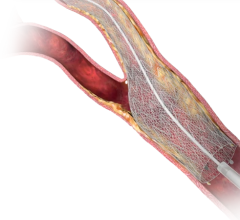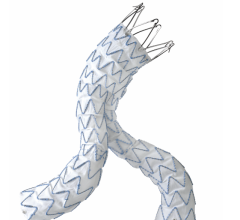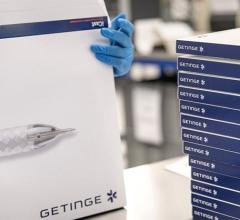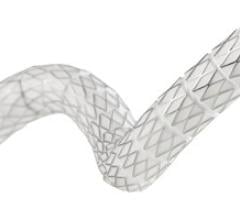March 26, 2013 — A multicenter analysis, led by Weill Cornell Medical College and published in the Journal of Clinical Gastroenterology, shows the use of temporary "fully covered self-expanding metal stents" (FCSEMS) can effectively fix a painful and potentially life-threatening benign biliary stricture — a severely blocked or narrowed bile duct.
"Benign biliary strictures can be managed and resolved with these new fully covered metal stents with flared ends. Our study findings are similar to the recent European study results in patients overseas who received the metal stents," said Michel Kahaleh, M.D., chief of endoscopy, Division of Gastroenterology and Hepatology, Department of Medicine, Center for Advanced Digestive Care at NewYork-Presbyterian Hospital/Weill Cornell Medical Center, and professor of clinical medicine at Weill Cornell Medical College.
Narrowing or blockage of a bile duct can lead to the dangerous leakage of bile into the body's organs and bloodstream. Patients who experience a bile duct stricture may experience jaundice, severe pain, itchiness, weight loss, elevated liver function tests, cirrhosis and liver failure over a period of a few weeks. Biliary strictures can be cancerous or benign, and can occur as a result of surgical injury or trauma, pancreas inflammation, scarring or hardening of bile duct tissue caused by chronic inflammation, recurrent gallstones or poor reconnection of tissues post-liver transplantation. They are often diagnosed with explorative endoscopy, computed tomography (CT) or magnetic resonance imaging (MRI).
Today, minimally invasive endoscopic stent placement has emerged as a less invasive and more successful therapeutic option for treatment of biliary strictures. Only permanent plastic stents are currently approved by the U.S. Food and Drug Administration (FDA) for benign stricture indications. However, these plastic stents involve multiple endoscopic procedures and multiple large stents, and are often associated with stent blockages and failure of long-term durable results for stricture resolution.
FCSEMS are being tested in patients with benign biliary strictures to overcome the limitations of plastic stents, and the complications of their uncovered or semi-covered metal stent counterparts. The fully covered membrane design of FCSEMS prevents embedding and in-growth of the stent into the bile duct's wall.
The research study examined 133 patient cases performed between April 2009 and October 2010 at six centers. Each patient received a FCSEMS during an endoscopic stenting procedure to open a severely narrowed or blocked benign bile duct stricture and restore bile flow. A 40, 60 or 80 mm metal stent was implanted via a thin catheter to the blockage site over a guidewire. The stent was then partially deployed and pulled against the stricture prior to full deployment. These temporary metal stents were implanted all in one endoscopic procedure and removed after an average of three months.
This study is the first to analyze the safety and efficiency of implanted metal stents for benign stricture resolution after their removal. "The study showed the majority of patients who received a metal stent had symptom relief, negative imaging for stricture and no need for repeat stent replacement except the patients who underwent liver transplant," said Kahaleh.
Stricture resolution after FCSEMS removal was 91.6 percent successful in post-surgical cases; 84.2 percent in gallstone-related disease; chronic pancreatitis 80.7 percent; 80 percent in other etiology; and, in more complex anastomotic strictures cases, 61.2 percent. Patients who had stents placed for more than three months were 4.3 times more likely to have resolved strictures, while those with non-migrated stents were 5.4 times more likely to have resolved strictures. Also, nearly 73 percent of metal stents were successfully removed after an average of three months.
"Fully covered self-expanding metal stents are emerging as a promising therapeutic option in the treatment of benign bile duct strictures," Kahaleh said. "We found very acceptable, high rates of stricture resolution after the use and removal of metal stents in all types of patients groups. Also, those with longer duration of stent placement that didn't migrate had an increased likelihood of stricture resolution."
Current data and the FDA support the use of plastic stents in the endoscopic treatment of benign bile duct blockages. However, this study reports that previous plastic stenting does not always hold up. In fact, the study shows failed plastic stenting had been performed in more than half of the study’s patients who underwent metal stent implants. Also, researchers report previous plastic stenting was associated with a decreased rate of stricture resolution.
The researchers report FCSEMS did have some minor complications in the patient population studied. After implantation, complications included stent migration (10.5 percent), post-procedural pain requiring hospital admission (6 percent), pancreatitis (2 percent), and stent occlusion (3 percent). Also, minimal stent removal complications included mild bleeding (1 percent), unraveling of the stent (2 percent) and hyperplastic reaction (1 percent).
According to the research team, further research investigation of FCSEMS is necessary in a prospective, multicenter randomized control trial to assess the long-term efficacy of metal stents with a more than three-month average period of stent indwelling time.
For more information: www.nyp.org


 November 24, 2025
November 24, 2025 









